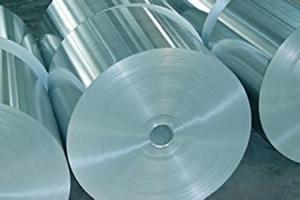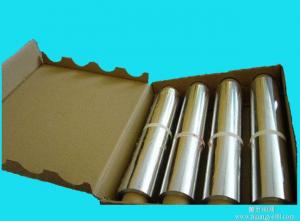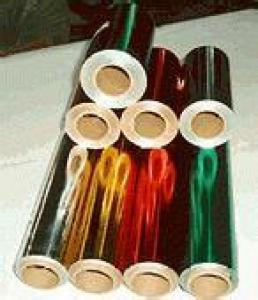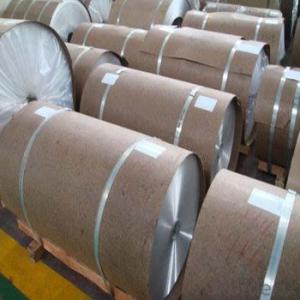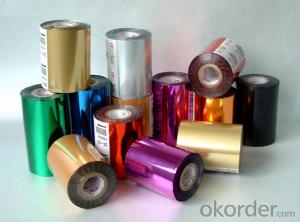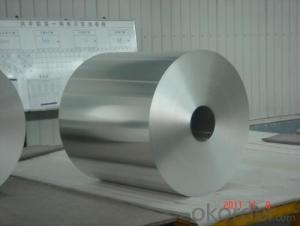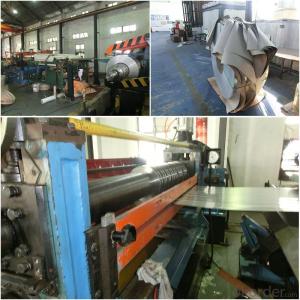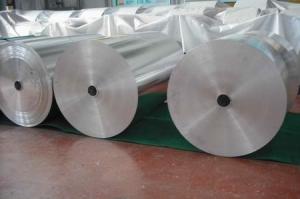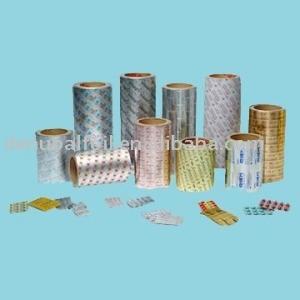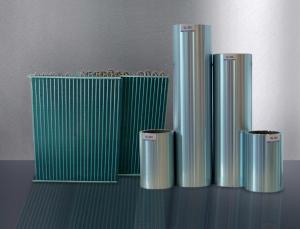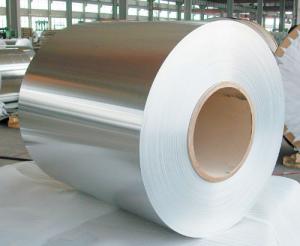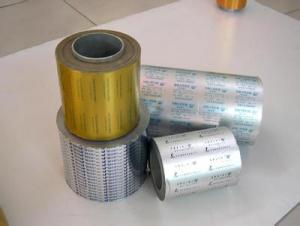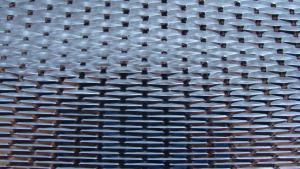Aluminum foil for airconditional use
- Loading Port:
- China Main Port
- Payment Terms:
- TT OR LC
- Min Order Qty:
- -
- Supply Capability:
- -
OKorder Service Pledge
OKorder Financial Service
You Might Also Like
Aluminium foil acts as a total barrier to light and oxygen (which cause fats to oxidise or become rancid), odours and flavours, moistness, and germs, it is used broadly in food and pharmaceutical packaging. The purpose of aluminium is to make long-life packs (aseptic processing|aseptic packaging) for drinks and dairy goods, which allows storing without refrigeration. Aluminium foil containers and trays are used to bake pies and to pack takeaway meals, ready snacks and long life pet foods.
Aluminium foil is widely sold into the consumer market, often in rolls of 500 mm (20 in) width and several metres in length.It is used for wrapping food in order to preserve it, for example, when storing leftover food in a refrigerator (where it serves the additional purpose of preventing odour exchange), when taking sandwiches on a journey, or when selling some kinds of take-away or fast food. Tex-Mex restaurants in the United States, for example, typically provide take-away burritos wrapped in aluminium foil.
Aluminium foils thicker than 25 μm (1 mil) are impermeable to oxygen and water. Foils thinner than this become slightly permeable due to minute pinholes caused by the production process.
Aluminium foil has a shiny side and a matte side. The shiny side is produced when the aluminium is rolled during the final pass. It is difficult to produce rollers with a gap fine enough to cope with the foil gauge, therefore, for the final pass, two sheets are rolled at the same time, doubling the thickness of the gauge at entry to the rollers. When the sheets are later separated, the inside surface is dull, and the outside surface is shiny. This difference in the finish has led to the perception that favouring a side has an effect when cooking. While many believe that the different properties keep heat out when wrapped with the shiny finish facing out, and keep heat in with the shiny finish facing inwards, the actual difference is imperceptible without instrumentation.The reflectivity of bright aluminium foil is 88% while dull embossed foil is about 80%.
We provide a full range of precision aluminum strip for almost any application. We produce aluminum strip in a wide variety of alloys, including clad composites. Our aluminum strip can be produced in standard dimensions or custom made to your special requirements. We produce both imperial and metric units. We manufacture in compliance with the main international specifications, and tighter tolerances or custom tempers are available upon request. We offer various surface conditions, custom finishes (painting, anodizing, embossing), special processing, and multiple packaging options to meet our customer's unique requirements. The following is a summary of our capabilities.
Manufactured in compliance with the main international specifications and standards, including: Aluminum Association, ASTM, EN, and DIN.
We can also manufacture in compliance with other international standards including:ASME, SAE, AMS, AWS, FED, MIL, QQ, ISO, BS, AFNOR, JIS and GOST.
Manufactured in compliance with the main international specifications and standards.
Tighter tolerances are available upon request.
Aluminium (or aluminum; see spelling differences) is a chemical element in the boron group with symbol Al and atomic number 13. It is a silvery white, soft, ductile metal. Aluminium is the third most abundant element (after oxygen and silicon), and the most abundant metal in the Earth's crust. It makes up about 8% by weight of the Earth's solid surface. Aluminium metal is so chemically reactive that native specimens are rare and limited to extreme reducing environments. Instead, it is found combined in over 270 different minerals.The chief ore of aluminium is bauxite.
Aluminium is remarkable for the metal's low density and for its ability to resist corrosion due to the phenomenon of passivation. Structural components made from aluminium and its alloys are vital to the aerospace industry and are important in other areas of transportation and structural materials. The most useful compounds of aluminium, at least on a weight basis, are the oxides and sulfates.
Despite its prevalence in the environment, no known form of life uses aluminium salts metabolically. In keeping with its pervasiveness, aluminium is well tolerated by plants and animals. Owing to their prevalence, potential beneficial (or otherwise) biological roles of aluminium compounds are of continuing interest.
The earliest citation given in the Oxford English Dictionary for any word used as a name for this element is alumium, which British chemist and inventor Humphry Davy employed in 1808 for the metal he was trying to isolate electrolytically from the mineral alumina. The citation is from the journal Philosophical Transactions of the Royal Society of London: "Had I been so fortunate as to have obtained more certain evidences on this subject, and to have procured the metallic substances I was in search of, I should have proposed for them the names of silicium, alumium, zirconium, and glucium."
Davy settled on aluminum by the time he published his 1812 book Chemical Philosophy: "This substance appears to contain a peculiar metal, but as yet Aluminum has not been obtained in a perfectly free state, though alloys of it with other metalline substances have been procured sufficiently distinct to indicate the probable nature of alumina."[69] But the same year, an anonymous contributor to the Quarterly Review, a British political-literary journal, in a review of Davy's book, objected to aluminum and proposed the name aluminium, "for so we shall take the liberty of writing the word, in preference to aluminum, which has a less classical sound."
The -ium suffix conformed to the precedent set in other newly discovered elements of the time: potassium, sodium, magnesium, calcium, and strontium (all of which Davy isolated himself). Nevertheless, -um spellings for elements were not unknown at the time, as for example platinum, known to Europeans since the 16th century, molybdenum, discovered in 1778, and tantalum, discovered in 1802. The -um suffix is consistent with the universal spelling alumina for the oxide (as opposed to aluminia), as lanthana is the oxide of lanthanum, and magnesia, ceria, and thoria are the oxides of magnesium, cerium, and thorium respectively.
The aluminum spelling is used in the Webster's Dictionary of 1828. In his advertising handbill for his new electrolytic method of producing the metal in 1892, Charles Martin Hall used the -um spelling, despite his constant use of the -ium spelling in all the patents[58] he filed between 1886 and 1903. It has consequently been suggested[by whom?] that the spelling reflects an easier-to-pronounce word with one fewer syllable, or that the spelling on the flyer was a mistake.[citation needed] Hall's domination of production of the metal ensured that aluminum became the standard English spelling in North America.
- Q:Where to buy the Aluminium Foil products ?
- Look for aluminum foil in the grocery aisle the has waxed paper, plastic wrap, and zip top baggies. Look for disposable aluminum foil pans in the baking aisle. Or possibly in your grocery there is a seasonal aisle since this may be considered a grilling or picnic usage item. If you still can not locate the items you need I am sure there are employees that the store has on hand to answer this very type of question. Since they get paid to stock the shelves they will know where they have hidden this particular item.
- Q:Felix has placed some Aluminum (where the official looked up inferred absolute temperature is 236 Celsius) 24 gauge wire in a toaster oven at 275 degrees FahrenheitHe measures the resistance of the HOT wire to be 6.21 ohmsWhat is the length of the wire? Be sure to state the answer in feet to exactly the tenths place (ie rounded to ONE decimal places such that the number has the form of where represents some numerals that are CORRECT!) In other words, only express your answer with 4 numbers and a period/decimal point in the form of: .I don't know how to do it! Any help?
- diameter of 24-gauge wire ordinarily 0.511 mm, at (I think) 25 Celsius Resistivity of aluminum 2.65 x 10^(-8) ohm meter at 20 C Temperature increases resistivity by a factor 1.0038 per degree C Temperature increases diameter by a factor 1.0000023 per degree C Now use R (resistivity)(length) / (pi r^2) after correcting both the diameter and the resistivity for the temperature changeThe only unknown in the equation is length; also note that the length you will calculate will be the HOT length, which perhaps they wanted corrected to room temperatures.
- Q:Your average pop can in the US is 4.75 inches tall and 2.5 inches wide with a volume of 23 cu inIf aluminum can manufacturers would change the dimensions to 3.09 inches tall and 3.08 inches wide it would maintain the same volume yet the can would have a lower surface areaA lower surface area means less aluminum needed to make the canLess aluminum means the can will be cheaper to produce and more environmentally friendlyThe saving per can would be pretty small, however with the amount of pop being drunk per year this would add up to a huge revenue boost for the pop manufacturers.Is there any logical reason to keep the less efficient can size?
- Yes! Great question, by the wayThe reason that pop cans are shaped the way they are is due to them being shipped by airIf cans had the dimensions that you mentioned, they would explode at a high altitudeThere is also a small space between the liquid and the top of the can to help prevent this, so a little extra aluminum is neededThe dimensions of soda pop cans use the least amount of aluminum possible, while allowing the cans to be freighted by air without the risk of explosionEdit: Trust meIt is the air freight thingSend an email to a soda pop can producer and ask them if you don't believe me.
- Q:What is this kind of Aluminum Profile called?
- FFS what proportion money owed have to procure FFS? and to answer your question a million) it relies upon on the size of the peg 2) it relies upon on the size of the hollow 3) in case you have have been given a sqdick see a physicianAlrighty enormous guy, i'm lower back from my vacations, Sam and that i stay at the same time now and we are the two satisfied as could bewe've a kitten stated as gizmo and our Flat is calling extremely completedesire each and every thing has been good at the same time as i replaced into away, i will see how plenty you ignored me, lolcommunicate to you quickly.
- Q:If 3.00g of aluminum hydroxide reacts with 1.00g of sulfuric acid according to the balanced equation, what is the mass of water produced?Al(OH)3 (s) + H2 SO4 (l) -gt; Al2 (SO4)3 (aq) + HOH (l)the answer is 8.367g H2O Limited reactant (LR) is H2SO4How do you do this problem???
- first you have to convert 3.00g of Al(OH)3 to the number of moles of Al(OH)3to do that you have to find the molecular mass of Al(OH)3 by adding aluminun (26.98 g/mol) to three of OH, which is 16+117 .times 3 51 g/mol and add that to aluminun which you should get 77.98 g/molto find the number of moles in 3.00g of Al(OH)3, you simply have to do 3.00g / 77.98 g/mol, getting .038 moles of Al(OH)3you must do the same for sulfuric acid with the 1.00g, you should get for the molecular mass 98.1g/moland divide that from 1.00g to get0.0102 moles of sulfuric acidand you should known by the coefficients of Al(OH)3 and H2 SO4, that ONE MOLE of Al(OH)3 added to ONE MOLE of the acid creates the water and stuff so .0102 MOLES OF H2SO4 WILL MATCH .0102 MOLES OF ALUMINUM HYDROXIDE TO FORM THE WATERbut there is still 0.0278 moles of the hydroxide left, making the acid the limited reactantso you will also tell by the coefficients that every mole of the hydroxide OR the acid will equal the moles of water(one mole of hydroxide + one mole of acid one mole of water) so there is 0.0102 moles of H20, or HOHand you should know that the molecular mass of water is 18.00 g/molso do the opposite of what we did in the beginning to find the number of moles and multiply the molecula mass of water by the moles to leave you with the number of grams, which isOH DANG IT!!! THAT EQUATION ISN'T FREAKING BALANCED AT ALL!!!! i guess you'll have to balance the equation first before you do all the stuff i just said.
- Q:what type of foil is there that is not aluminum foil that can be used to clean tarnish off silver
- volume of water equals to volume of ship.
- Q:I bought a big container of blackstrap molasses from the local natural store and I hate the stuff! But its really good for you I hear and I want to use it upBut how? Does anyone know any recipes/ways to use it and not totally gag? Thank you for your input.
- Pistachio nuts hs the best concentration of fiber and protein, of all nutsA fistful is only 340 caloriesPlus, that thin rind that covers the edible nut.is actually pure antioxidant!
- Q:Performing an experiment about Thermal expansionabout a aluminium tube and copper tube having a connection with steam water in one end of the tube and steam comes out on the other side.water is left inside the tube when the experiment is finishedand you conduct another experiment without removing the water inside the tubethe question is:Would the result be different if the condensed water was not drained from the expansion tube? why?
- Would the result of the second experiment (which we don't know anything about) be different? Well, lets say the second experiment is to determine the amount of water contained in the tubeWell, obviously, if water is left in the tube, then the results would be different if you dried it out first or not.
- Q:A popular soda distributor has just hired you to design a new package that is to be a larger version of the can they already useThe small can they already use holds 340ml of soda, has a radius of 6cm and hieght of 12cmFind the dimensions( radius and height) and the amount of aliminum needed to produce a can that will hold 850ml of sodaAny ideas how to do this?
- No they do not have any liability for the damage and thefts unless the security gates are malfunctioning and they refused to make repairs after being put on notice.
1. Manufacturer Overview |
|
|---|---|
| Location | |
| Year Established | |
| Annual Output Value | |
| Main Markets | |
| Company Certifications | |
2. Manufacturer Certificates |
|
|---|---|
| a) Certification Name | |
| Range | |
| Reference | |
| Validity Period | |
3. Manufacturer Capability |
|
|---|---|
| a)Trade Capacity | |
| Nearest Port | |
| Export Percentage | |
| No.of Employees in Trade Department | |
| Language Spoken: | |
| b)Factory Information | |
| Factory Size: | |
| No. of Production Lines | |
| Contract Manufacturing | |
| Product Price Range | |
Send your message to us
Aluminum foil for airconditional use
- Loading Port:
- China Main Port
- Payment Terms:
- TT OR LC
- Min Order Qty:
- -
- Supply Capability:
- -
OKorder Service Pledge
OKorder Financial Service
Similar products
New products
Hot products
Hot Searches
Related keywords
